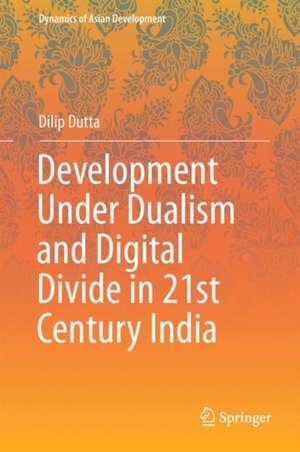Development under Dualism and Digital Divide in Twenty-First Century India: Dynamics of Asian Development
Autor Dilip Duttaen Limba Engleză Hardback – 2 oct 2017
This book tests the validity of these arguments, and provides readers a deeper understanding of the structural and institutional elements of the articulation of Indian society. It also examines the paradoxical political and economic effects ofthe information and communication (ICT ) industry in India, due to the economic disparities between the beneficiaries of the ICT windfall and those unable to reap those benefits. Lastly, by investigating the integration of key traditional sectors into modern sectors, the book provides policy suggestions for tackling the sectoral and segmental disarticulation that currently characterises Indian society.
| Toate formatele și edițiile | Preț | Express |
|---|---|---|
| Paperback (1) | 559.99 lei 38-44 zile | |
| Springer Nature Singapore – 23 dec 2018 | 559.99 lei 38-44 zile | |
| Hardback (1) | 645.14 lei 3-5 săpt. | |
| Springer Nature Singapore – 2 oct 2017 | 645.14 lei 3-5 săpt. |
Preț: 645.14 lei
Preț vechi: 758.99 lei
-15% Nou
Puncte Express: 968
Preț estimativ în valută:
123.46€ • 126.44$ • 102.70£
123.46€ • 126.44$ • 102.70£
Carte disponibilă
Livrare economică 26 februarie-12 martie
Preluare comenzi: 021 569.72.76
Specificații
ISBN-13: 9789811063428
ISBN-10: 9811063427
Pagini: 211
Ilustrații: XXV, 211 p. 8 illus. in color.
Dimensiuni: 155 x 235 mm
Greutate: 0.55 kg
Ediția:1st ed. 2018
Editura: Springer Nature Singapore
Colecția Springer
Seria Dynamics of Asian Development
Locul publicării:Singapore, Singapore
ISBN-10: 9811063427
Pagini: 211
Ilustrații: XXV, 211 p. 8 illus. in color.
Dimensiuni: 155 x 235 mm
Greutate: 0.55 kg
Ediția:1st ed. 2018
Editura: Springer Nature Singapore
Colecția Springer
Seria Dynamics of Asian Development
Locul publicării:Singapore, Singapore
Cuprins
Chapter 1. Development Dynamics in Two Dualistic Societies of Asia.- Chapter 2. Development in Modern India with Structural Dualism (1947-80).- Chapter 3. Economic Liberalisation and Structural Dualism (1980-2017).- Chapter 4. Role of Social Sector Development (1980-2017).- Chapter 5. Development under Digital Divide in India.- Chapter 6. Conclusion.
Recenzii
“Overall, the presentation of each chapter is easy to follow, and the issues are dealt with in non-technical language with the help of descriptive statistics. I congratulate the author on writing this book, which I believe will generate a great deal of interest among economists in universities, policy advisers in government and private sectors, and entrepreneurs interested in developments in the Indian economy.” (Mita Bhattacharya, Economic Record, Vol. 95 (310), September, 2019)
Notă biografică
Dilip Dutta is an Associate Professor of Economics at the University of Sydney, and Director of the University’s South Asian Studies Group. His current research interests include socio-economic dualism, trade liberalisation, endogenous growth, and the impact of information and communication technology (ICT) and services on economic growth and development in selected developing countries, including China and India. He is the founding editor of the International Journal of Development Issues (Emerald, UK).
Textul de pe ultima copertă
After first analysing the economic development processes of emerging Asian economies in general, this book explores the development implications of India’s seventy years (1947-2017) of socio-economic policy regimes. It discusses structural dualism and the digital divide, which it identifies as the major socio-economic structural elements of the Indian economy, along with the external forces of globalisation. Since the adoption of comprehensive economic reforms in 1991, India has been liberalising its economy, due in part to the rising pressures of globalisation. However, critics have argued that Indian liberalisation policy has aggravated unemployment, regional inequality and poverty, and also increased India’s external vulnerability.
This book tests the validity of these arguments, and provides readers a deeper understanding of the structural and institutional elements of the articulation of Indian society. It also examines the paradoxical political andeconomic effects of the information and communication (ICT) industry in India, due to the economic disparities between the beneficiaries of the ICT windfall and those unable to reap those benefits. Lastly, by investigating the integration of key traditional sectors into modern sectors, the book provides policy suggestions for tackling the sectoral and segmental disarticulation that currently characterises Indian society.
Caracteristici
Analyses the economic development processes of emerging Asian economies in an increasingly globalised world Explores the effects of the two major structural elements of its economy on India’s economic development – the dualism of its traditional and modern sectors, and the digital divide between the rich and poor Provides policy suggestions for tackling the sectoral and segmental disarticulation that currently characterises Indian society Includes supplementary material: sn.pub/extras










